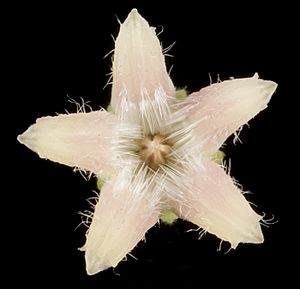Parsonsia diaphanophleba facts for kids
Quick facts for kids Parsonsia diaphanophleba |
|
|---|---|
 |
|
| Conservation status | |
| Scientific classification | |
| Genus: |
Parsonsia
|
| Species: |
diaphanophleba
|
| Synonyms | |
|
Lyonsia diaphanophlebia Benth. Lyonsia diaphanophleba (F.Muell.) Benth. |
|
The Parsonsia diaphanophleba is a special kind of woody vine. It belongs to the plant family called Apocynaceae. You can find this plant growing in Western Australia. It is considered a "priority 4" species, which means it is rare, possibly threatened, or needs to be watched carefully.
What is Parsonsia diaphanophleba?
This plant is a vine, which means it climbs and grows upwards. Its woody stems can grow quite long, reaching up to 10 meters high! That's like climbing to the top of a three-story building.
The Parsonsia diaphanophleba has pretty flowers that are white, cream, or pink. These flowers bloom at different times of the year, usually from January to February, April to June, or in September.
Where Does It Live?
The Parsonsia diaphanophleba lives in a specific part of Western Australia. It grows in the Jarrah forest areas, especially on the Swan Coastal Plain. This region is part of the Southwest Province.
You'll often find this vine growing along rivers. It prefers to grow in "alluvial soils," which are rich soils left behind by flowing water.
How It Got Its Name
The Parsonsia diaphanophleba was first officially described in 1861. A scientist named Ferdinand von Mueller gave it its first scientific name.
Later, in 1868, another scientist named George Bentham looked at the plant again. He gave it a slightly different name, Lyonsia diaphanophlebia. He also made a small change to the original Latin name. However, the name Parsonsia diaphanophleba is the one that scientists use today.


